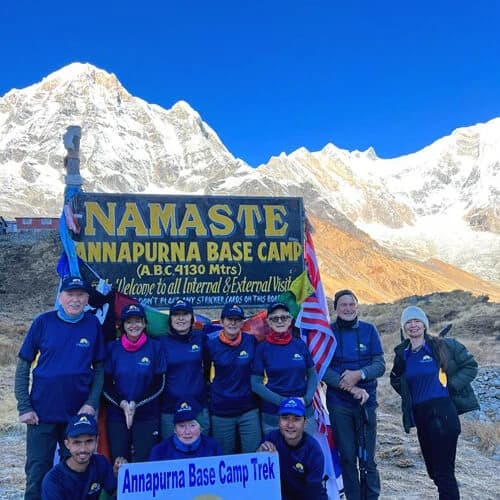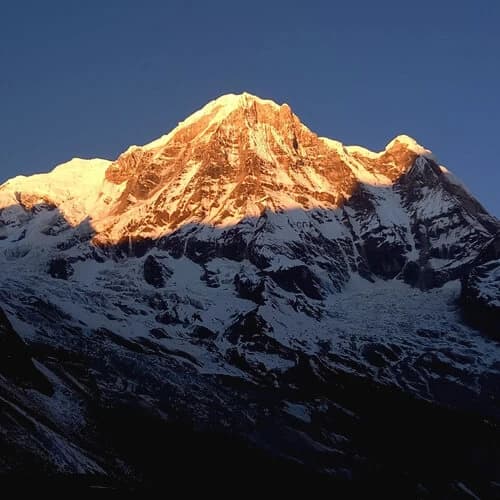Food on the Annapurna Base Camp Trek
Trekkers can find food and shelter along the Annapurna Base Camp Trekking trail at several locally operated lodging establishments and tea houses. In the Annapurna region, a typical teahouse or lodge has a good assortment of food items, however, you may not find everything you're looking for. The reason for this is that the track is still impassable by vehicle, and food must be transported to the lodge in the trail's most isolated locations by horses or porters.
During the peak seasons, a large number of hikers visit the Annapurna Base Camp. As a result, tea shops stock up for the season, which increases the likelihood that the menu will have greater variety. If, however, you are trekking during the off-season, you will have to make do with the limited selection of food items. Altitude also plays a major role in food availability. Higher-altitude teahouses usually have fewer alternatives due to limited supplies, but lower-altitude teahouses offer a greater variety of dishes.
Tea shops on the way to the Annapurna Base Camp serve both vegetarian and non-vegetarian meals. Non-vegetarian meals are not advised because eating meat at higher elevations might strain your metabolism and produce stomach issues. Additionally, it is best to avoid frozen food because it is unhygienic as it takes a long time to arrive at the tea shops. The worst thing that might happen is probably becoming sick in between hikes. Therefore, make an effort to cut back on your non-vegetarian eating habits and concentrate on eating locally-made vegetarian meals.
You will typically eat three meals a day when trekking in the Annapurna region: breakfast, lunch, and dinner. It's usually a good idea to keep some snacks on hand for instant energy boosts. Don't stuff your bags full of munchies, though. It would be difficult to carry.
Breakfast on the ABC Trek
The most crucial meal of the day while hiking is breakfast since it gives you the energy to tackle the trails in the morning. Thus, never skip breakfast! Usually, it is provided in the teahouse or lodge where you spend the night. Breakfast is served early in the morning, from 6 to 8 am, as you begin the hike early to avoid the midday sun. Nothing compares to savoring a hearty, filling breakfast while seeing the mountains illuminated by the sun's first light.
The cost of breakfast varies from $3 to $8 depending on altitude and the size of the portion.
Depending on your altitude, you can find different kinds of breakfast. Below are a handful of them:
Breakfast Set: This hearty meal gives you the energy boost you need to start the day's journey. It consists of toast, chapati, or Tibetan bread with hash brown potatoes, a boiled or omelet egg, and a hot beverage (tea or coffee).
Tibetan Bread: The traditional Tibetan bread is the most popular breakfast choice for hikers in the Himalayas. It's a flatbread that's deep-fried and topped with peanut butter, jam, or honey. Cheese and eggs can also be added to it.
Pancakes: In the lower elevations of the trail, a variety of pancakes, such as plain, chocolate, and banana variants, are offered with peanut butter or honey on top.
Cereals: For a lighter breakfast option, try some muesli, cornflakes, or porridge topped with fruit and milk or yogurt. If you're sick of Tibetan bread and pancakes every day, this is a healthier option.
Paratha: It is an Indian flatbread packed with potatoes, eggs, or other vegetables, usually served for breakfast.
If you prefer something simple, you can also have French toast, vegetarian soup, or eggs by themselves.
Lunch and Dinner on the ABC Trail
Midway through the hike, we stop for lunch at a tea house en route. You can eat lunch between 11 a.m. and 1 p.m., depending on how long the walk will take and whether there are tea shops along that particular section of the path. Lunch breaks usually last an hour or two, giving you time to relax while the food is being prepared. Stretching your body and taking in the view from your lunch spot are some excellent uses for your lunch break.
The teahouse/lodge where we stay the night serves dinner. After finishing the day's hike, we stay at the tea house or a lodge, freshen ourselves, and eat dinner in the dining hall. Most evenings, from 7 to 9 p.m., tea shops in the Annapurna Base Camp trail serve meals. Because it becomes cold outside in the evenings, there is a firewood stove in the middle of the dining hall where you have dinner.
Depending on availability and altitude, you can buy lunch or dinner for $4 to $10.
The Annapurna Base Camp Trek lodges offer the following options for lunch and dinner:
Dal Bhat: The most popular meal to eat for lunch and dinner on Nepal's Himalayan hiking paths is Dal Bhat. Bhat, or white rice, and daal, or lentil or pulse soup, are served with pickles, salad, and seasonal vegetables. For non-vegetarians, it comes with a side dish of chicken or mutton curry, while for vegetarians, it comes with a side dish of veggie curry.
Momo: Another popular dish from Nepal is momo, which is basically a steamed dumpling available in both vegetarian and non-vegetarian forms. It is served on the Himalayan routes and is widely accessible in Nepalese cities.
Thentuk or Thukpa: Noodle soup, also known as thukpa or thentuk, is another popular lunch or dinner option. It can be vegetarian or non-vegetarian. The flat, square-shaped noodle is called Thentuk, and the thin, long noodle is called Thukpa. It's served hot and comforting, making it the ideal meal for chilly weather.
Chowmein or Noodles: Tea establishments along the route offer chowmein, a distinctive type of Nepalese noodles. You can also enjoy a selection of quick-to-prepare, light, and delicious instant noodles.
Fried Rice: Another popular dish in Nepal is Fried Rice, which is basically cooked white rice mixed with various vegetables, eggs, or meat. You can have Fried Rice for lunch or dinner while hiking the Annapurna Base Camp Trail.
Rice and Curry: You can also have rice with a simple chicken or vegetable curry if the full-course Dal Bhat menu doesn't appeal to you.
Pizza: You can get any kind of pizza for lunch or dinner in restaurants located at lower altitudes. However, they might not be of the highest caliber.
Pasta or Spaghetti: Pasta and spaghetti seasoned with tomato sauce, vegetables, meat, or eggs are also available in the trek's lower sections.
These are the most common dishes found on walking paths of the Annapurna Base Camp. At lower altitudes, you have more options; at higher elevations, you might not have access to all of them. Additionally, the availability of food supplies varies according to the time of year you climb. In the off-season, there are fewer visitors and therefore fewer choices. Even in the off-season, there will be enough available lodges to house and feed the few visitors to the Annapurna Base Camp.
Snacks for the ABC Journey
The day hike usually concludes at 3:00 or 4:00 p.m. After the day hike, you can take a small snack because dinner won't be for another several hours. You can eat whatever you packed, or you can ask the teahouse staff to make you something quick, like instant noodles. At high altitudes, snacks are costly. Thus, you can bring along some portable snacks, such as cup noodles, protein or chocolate bars, biscuits, etc.
Drinks on the Annapurna Base Camp Trek
Sustaining sufficient hydration is imperative for a triumphant journey, particularly in the elevated Annapurna area. Drinking enough fluids significantly reduces the chance of altitude sickness. Consequently, the trail offers a selection of locally brewed and brought-along drinks to assist you in maintaining a healthy water level. Let's find out more about the drinks that tea stores along the Annapurna Base Camp Trek route serve.
Drinking Water
The most essential drink to have when trekking is water. Since trekking causes higher water loss through sweat, one should drink 4 liters or more of water each day to stay hydrated. Drinking water to stay hydrated aids in the prevention of altitude sickness and improves daily adaptation to the rising altitude.
Due to the isolated location, the ABC trails do not have access to drinking water. Locals depend on naturally occurring water sources such as springs and rivers, which are dangerous for visitors to consume directly. As a result, the tea houses warm up water for their customers. While boiled water is complimentary at the tea house where you stay, a liter of boiling water from the tea shops along the road will cost you $1 or $2. If you're still unsure if boiled water is appropriate to drink, you can further cleanse it by adding tablets or a purifying liquid. Filtering water from natural sources along the way and keeping a water bottle with a built-in filtration system is the best option.
For $1 to $2, you can also buy bottled water, though we strongly advise against using single-use plastic bottles on the path because the Annapurna trails are becoming more and more littered with plastic waste.
Hot Drinks
Hot drinks such as tea and coffee are readily offered on the Annapurna Base Camp trek. For years, tea and coffee have been a popular companion for hikers in the Himalayas. Drinking tea and coffee after a long day becomes a relaxing habit. Moderate amounts of tea and coffee provide your body with the caffeine it needs to sustain energy levels for the duration of the hike. Tibetan tea, milk tea, black tea, mint tea, ginger tea, lemon tea, and green tea are the options available to you. You can also get a black coffee or milk. Hikers also take pleasure in consuming hot lemon with ginger honey and garlic soup, which are great remedies for altitude sickness.
A hot beverage can run you anywhere from $2 to $5, depending on what you're drinking and the altitude you're at.
Soft/Cold Drinks
In the ABC trails, soft drinks including Coca-Cola, Fanta, Sprite, Pepsi, canned juice, energy drinks, etc. are easily available. You can have a fair share of these cold drinks to quench your thirst. However, soft drinks contain caffeine, and consuming too much of it could dehydrate you and make altitude sickness worse. Thus, consume soft drinks sparingly. These beverages may be more expensive than the MRP, and the price increases as altitude rises.
Alcoholic Beverages
You will find a wide variety of regionally produced alcoholic beverages with unique flavors and cultural importance available for consumption in the Annapurna region. There's plenty of internationally recognized beer, whiskey, rum, and vodka here, along with an abundance of locally created raksi. You should avoid giving in to the temptation to indulge in these pleasures on a regular basis, especially while you're at a high altitude. Drinking alcohol causes your body to become dehydrated, which raises your risk of altitude sickness. Thus, exercise caution when consuming alcoholic beverages and abstain from them entirely when climbing.
Accommodation on the Annapurna Base Camp Trek
Back in the day, when hiking was still relatively new in the Himalayas, the Annapurna region was a favorite destination for trekkers who wanted to camp. But now, everything is quite different. Unless you wish to, you are no longer required to sleep in tents. There are plenty of comfortable lodging options along the trail, including tea houses, mountain lodges, and homestays that cater to hikers' needs. When trekking to the Annapurna Base Camp, lodging won't be a problem for you. However, during the busiest season, reservations for lodging must be made well in advance. Due to a shortage of rooms during the busiest trekking season, hikers occasionally have to spend the night in the dining hall.
The cost of accommodation varies depending on the hiking season and the height gained on the trip. Staying at lower elevations costs $3 to $5 USD during peak travel season. But as you move higher, accommodation costs increase and eventually approach $7 to $10 USD. In low season, lower elevation lodging costs $2 to $3 USD. But as you move higher, the cost increases to roughly $5 to $7 USD.
Tea Houses
The most common and traditional type of lodging on the ABC hiking path is a teahouse. They are typically found near the hiking routes in a little community. A tea house is owned by a local and is essentially a house with a few spare rooms reserved for overnight stays by hikers. These tea houses come in a variety of styles, ranging from affordable models with simple amenities to more lavish models with features like Wi-Fi and hot showers.
Common facilities provided by teahouses include twin-bedded rooms, community dining areas, and shared bathrooms (sometimes with squat toilets). The owners of the teahouse are warm and inviting, and the ambiance is nice as well. You can talk with other hikers, share experiences, and find out about the condition of the trail at the tea houses.
Mountain Lodges or Guest Houses
Mountain lodges or guest houses are larger and cozier than teahouses and are also typically more expensive. Along with private bathrooms and hot showers, guest homes frequently feature Western cuisine. Usually found in bigger towns or villages, they could have additional features like a free internet connection. Some luxury lodges provide room heating or electric blankets, which is a welcome bonus on cold nights. Most of these guest houses are in excellent places from where you can enjoy the breathtaking mountain views.
Homestays
In addition to lodges and tea houses, a number of villages in the Annapurna region, including Ghandruk and Ghorepani, provide homestays. You may thoroughly immerse yourself in traditional Nepali cultures through homestays. The villagers will host you and your family at their house. You will discover how the climate and topography affect day-to-day living in the Himalayan villages in addition to learning about the customs and way of life of the locals.
Camping
Some adventurous people who would like to have a more traditional camping experience can even camp their way to the Annapurna Base Camp and back. Since you have to carry all of your necessities along on the journey, camping could be more challenging than staying at a tea house. Thus, you'll need porters to assist you with carrying the camping supplies.
What does a standard tea house or a mountain lodge on the ABC trek offer?
The lodges and tea houses on the Annapurna Base Camp Trek are built with sturdy stone walls and have small, plainly furnished rooms. You will be using shared facilities with Asian squat toilets for the majority of the hike. In addition to having decent rooms, tea houses and lodges have a kitchen where food is prepared and a communal eating area with a fireplace.
Twin Rooms
The lodges and tea houses on the Annapurna Base Camp Trek are built with sturdy stone walls and have small, plainly furnished rooms. You will be using shared facilities with Asian squat toilets for the majority of the hike. In addition to having decent rooms, tea houses and lodges have a kitchen where food is prepared and a communal eating area with a fireplace.
Dining/Communal Area
Communal dining areas are for trekkers staying in lodges and tea shops to exchange tales of their adventures while having food. The eating area is heated and water is boiled by a fireplace in the middle of the room. Gathering around the fireside to exchange stories and laughs is a great way to cap off a long, tiring day. The common area also features tables or benches where individuals can sit and eat.
Restrooms
During the excursion, private restrooms with western toilets and running water may be available at lower elevations; but, at higher elevations, you will have to use shared restrooms with Asian-style squat toilets. There may not always be running water, but containerized water will always be available. It is important to bring your own toiletries for sanitary reasons because toilet paper and other supplies sometimes run out. It's not a good idea to take regular baths in this very cold weather, even when you can get hot showers for $2 or $3.
Internet Service or WiFi
We cannot entirely depend on the free WiFi that certain lodges provide to hikers, especially those at higher elevations. In general, WiFi coverage is spotty and constrained. Therefore, using mobile data is recommended anywhere there is network coverage. You may buy an NTC or Ncell SIM card in Kathmandu and use its mobile data while on the way.
Power Supply
Solar energy is used to illuminate the eating area, kitchen, and rooms in places without hydroelectric supplies. Although there are no charging plugs in the rooms, there will be a charging station in the common area where you can charge your phones, camera batteries, power banks, torches, and other gear. Please be mindful of other users when using the charging station, as it is designed to accommodate all of the trekkers' devices staying at that particular teahouse.
Conclusion
To sum up, the Annapurna Base Camp Trip provides plenty of food and cozy lodging. But don't anticipate staying in luxurious accommodations like those in Kathmandu and Pokhara. It's easy to finish the trip because there are plenty of food and accommodation alternatives along the route to ABC. Make sure you have enough clothing and a sleeping bag to keep warm throughout the night. Maintain hydration, eat healthily, and avoid illness. There is no other way to complete the Annapurna Base Camp Trek successfully.
For additional information on trekking in the Annapurna region, please contact us by Whatsapp at +977 9851137385 or email at info@outfitternepal.com. We’d love to help you out. Happy Trekking!
Some Most Popular Treks




